Previous: Sick Day Monday post (12)
Next: Beyond Basketry at the MFA (31)
Providence Poster Art
Post #893 • October 24, 2006, 3:18 PM • 6 Comments
Providence — "Providence Poster Art, 1995-2005" is part of a larger exhibition at the RISD Museum called "Wunderground: Providence, 1995 to the present." The museum installed 2000 posters in three rooms, floor to ceiling, conveying the ferment in the Olneyville neighborhood at the time: rent was cheap, police presence scant, and musical and printmaking talents were intersecting with punk-fueled frenzy. Everyone concedes that the moment has passed - its locus, Fort Thunder, dubbed so by its nigh-squatter inhabitants, was demolished in 2002, not long after its profile in nest magazine came out - but the scene exerted lasting influence. Lightning Bolt, formed there by RISDoids, just had the honor of being deported from Japan, and the catalogue shows a criminally uncredited Kaiju Big Battel performance at Fort Thunder. Too, it set the bar for contemporary countercultural artistic achievement. Silkscreen prodigies coming out of RISD made posters for these events and many others, resulting in a yeasty visual record fusing comics, collage, grafitti, and sweet design skills. Said catalogue is available, executed with the kind of workmanship that RISD prides itself on. If only a soundtrack came with it.
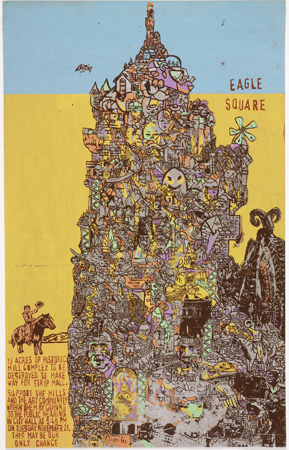
Brian Chippendale, Save Eagle Square, 2001, screenprinted poster. Image courtesy of the artist. Collection of Brian Chippendale. Photography by Erik Gould.
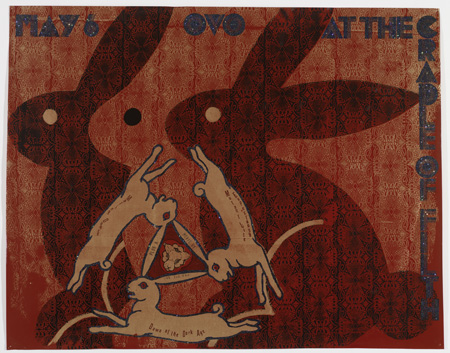
Pippi Zornoza, Ovo, 2005, screenprinted poster. Image courtesy of the artist. Collection of Sasha Wiseman. Photography by Erik Gould.
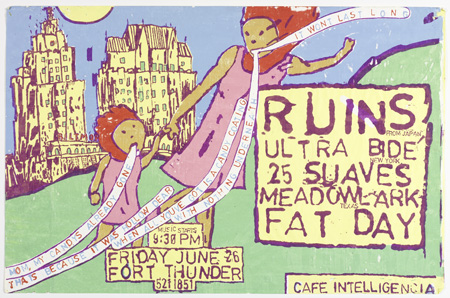
Brian Chippendale, Ruins, 1998, screenprinted poster. Image courtesy of the artist. Collection of Brian Chippendale. Photography by Erik Gould.
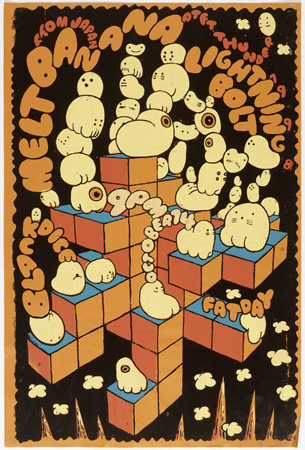
Mat Brinkman, Meltbanana, 1998, screenprinted poster. Image courtesy of the artist. Collection of Brian Chippendale. Photography by Erik Gould.
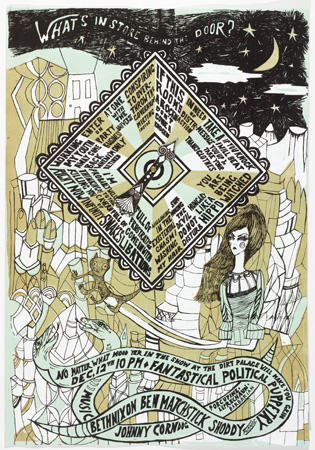
Xander Marro, Fantastical Political Puppetry, 2003, screenprinted poster. Image courtesy of the artist. Collection of Erin Rosenthal. Photography by Erik Gould.
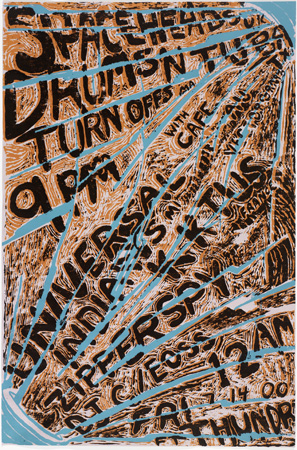
Leif Goldberg, Spaceheads, 2000, screenprinted poster. Image courtesy of the artist. Collection of Brian Chippendale. Photography by Erik Gould.
Related: museum slideshow.
2.
October 24, 2006, 7:04 PM
more Fort here: http://fortthunder.org/
3.
October 24, 2006, 10:37 PM
I know what you mean, Stephan. It does seem that sites like the ones you mentioned are diluting the real sense of art. But really, the fact that companies like Wallsneedart.com and Art.com are offering art prints cheaply, and are spreading art to the masses should be a good thing. We all need the attention, and the days of the starving artist might be dwindling - maybe towards the barely surviving artist?
4.
October 24, 2006, 11:00 PM
Former gang member turned painter, Michael Vasquez depicts hustlers and dealers from his past. These dynamic portraits convey aggression and a sense of loss for the part these men played as role models for the artist. His work is currently on view in Metro Pictures at the Museum of Contemporary Art in Miami and a solo exhibition is planned at The Kemper Museum of Contemporary Art in Kansas City, Missouri, later this year.
5.
October 25, 2006, 8:55 AM
Stephan, I think that artists who want to explore selling works for high-two- and low-three-digit prices could do so pretty successfully over the Web, directly to the buyer, and someone with silkscreen abilities is especially poised to do so. It's not so much a question of whether would people in general would buy real art vs. a Van Gogh reproduction, but how to reach the people who would buy the real art. Someone would. I doubt it would effect the larger market much at all.
6.
October 25, 2006, 11:47 AM
For the sake of full disclosure, Mr Schier might have wanted to tell
everyone about his marketing relationship with the company he lists.
I think most people who read this site know the [huge] difference between
a Café Press type product & what Franklin is showing here!
1.
Stephan Schier
October 24, 2006, 6:35 PM
The celebration of a poster art show illuminates some trends. In this do-it-yourself age, art faces the same wave of change as music and film.
Sales channels for artists had been fairly well established until the advent of Ebay, Etsy, Cafe Press and now a host of other print-on-demand photo sharing sites like Flickr. With the advent of giclee printing technology, artists can now sell their reproductions from virtual storefronts. “Fine" wall art is ever further being commoditized.
But what influence do artists really have over this market? ImageKind offers artists print and frame-on-demand services through their online galleries. Seemingly, now artists can sell framed wall art and compete with the mass-market "museum art" poster sellers. ImageKind artists are selling framed "wall art" from the comfort of their laptops - all they need are digital scans of their originals. And, these artists set the prices - some of them very low. Does this dilute the value of all art? Or, does this simply give independent artists the edge they need to compete?
Many would argue that low-priced, open edition prints ruin the market for all artists. Some would argue that it is just a different product for a different audience - those who cannot afford originals and limited editions.
Do people really want affordable art from independent artists or would they rather own a framed Van Gogh reproduction or canvas giclee print of some other popular historical master? Only time will tell as more and more artists flock to the web and take advantage of print-on-demand and now frame-on-demand online services.